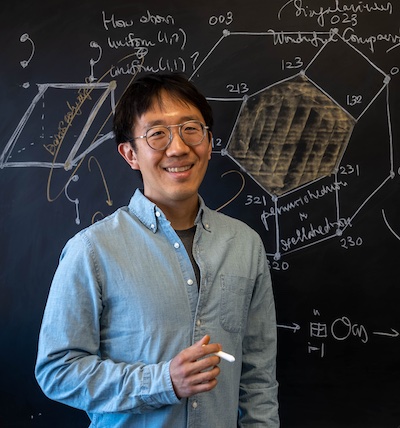
This is an easy introduction to the work of June Huh, you can read more of the mathematical details in this article.

June Huh. Photo: Lance Murphey.
June Huh, a mathematician of Princeton University, has won one of this year's Fields Medals at the International Congress of Mathematicians. The Fields Medal is one of the most prestigious prizes in mathematics. It is awarded every four years "to recognise outstanding mathematical achievement for existing work and for the promise of future achievement". Up to four mathematicians up to the age of 40 are awarded a Fields Medal each time.
Compared to other outstanding mathematicians, June Huh came to mathematics relatively late. At elementary school his grades in maths weren't great, and highschool got him so bored, he chose to write poetry instead. He eventually took a Physics and Astronomy course at Seoul National University. It was here that he noticed that the famous mathematician Heisuke Hironaka was giving a lecture course. "I knew nothing about the [mathematics] but I had read Hironaka's autobiography. He's an interesting person, so I enrolled."
The course turned out to be a real-time reflection on the research Hironaka was doing at the time, reporting on insights he had literally had the day before. "This was my first exposure to mathematics as a human activity," says Huh. It was the thrill of that human activity that got Huh hooked.Counting and seeing
Because he didn't have much maths training, Huh started his career focussing on objects "visible to the naked eye," as he puts it. An area of maths that delivers such objects is combinatorics: the art of counting things that lend themselves to being counted. A typical introductory question in combinatorics might ask is how many ways there are to order a pack of cards. "All the objects are tangible — you can almost see them and touch them," says Huh. "Combinatorics was the part of mathematics that was visible to my eyes."
See here for all our coverage of the ICM 2022 and the prizes awarded there.
Another area of maths that delivers tangible objects is geometry. "Geometry is common to all humans," says Huh. "We are visual creatures, vision is our primary sense organ. We understand the world around us through geometry as opposed to sound, taste or smell." While some geometric shapes are rather hard to describe formally (think of a knobbly potato) others, such as lines or spheres, can be described quite neatly using algebraic equations. The area of maths that uses equations to describe geometric objects is called algebraic geometry. And because you can "touch and feel" those equations, algebraic geometry was another area that appealed to Huh from the start.
Building bridges
Huh's work often builds bridges between different areas of maths, such as combinatorics and algebraic geometry. A result he is particularly proud of, which he proved with Petter Brändén, looks at the mathematical theory that underlies optimisation problems. These require you to minimise or maximise a certain quantity that depends on others: for example, when building a car you want to minimise fuel consumption, which depends on other variables like the car's weight and aerodynamic drag.
Mathematicians had a machinery for solving such problems when the relationships between the variables involved are continuous, and they also had some machinery when the relationships were discrete. The latter is more and more common in our modern digital world. Together with Brändén Huh found a connection between these two areas that was previously missing.
"Finding this formal bridge was very satisfying." says Huh. "And what was even more pleasant for us is that once you have this bridge you can approach problems that were considered very technical and difficult in a very natural and easy way."
Great advances in maths often happen when someone makes a connection between seemingly different areas. In some sense, though, Huh doesn't think we should be surprised by those connections. "It's not surprising because the subdivision of [mathematical] areas, or the subdivision of human intuition are just a result of millions of years of our experience as a species and the kind of sense organs we have. If we were a different kind of creature with a different kind of sense organs and a different kind of environment, we'd presumably have [developed] completely different areas of mathematics."
In that sense, the maths we develop is a mirror of our humanity. "It shows you who we are and how we think."
About this article
Marianne Freiberger and Rachel Thomas, Editors of Plus, interviewed June Huh in June 2022.
This content was produced as part of our collaborations with the London Mathematical Society and the Isaac Newton Institute for Mathematical Sciences. You can find all our content on the 2022 International Congress of Mathematicians here.

